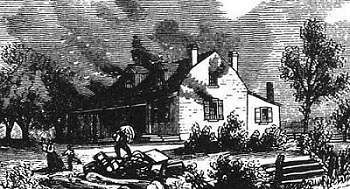“She lay on the snow watching the destruction of the house” --Charlotte Dickson

Under a starry night sky, unarmed townsfolk from Newark (now Niagara-on-the-Lake) in Upper Canada stood shivering in the December snow. They watched as members of the Canadian Volunteers, wearing grey uniforms and green-banded hats, raised their torches and set fire to each house. The Canadian Volunteers had lost their faith in British officials, and now fought for the Americans. Burning the town was an act of revenge and spite by men who felt betrayed by their government.
The Volunteers showed little mercy to the residents. Charlotte Dickson was ill, but she was nevertheless carried from her home and left to “lay on the snow watching the destruction of the house with a fine library valued at £600.” Her husband, William, had been arrested in May by American soldiers and imprisoned at Albany, leaving the family in its vulnerable position. Elizabeth Campbell, a widow, stood nearby with her four children—one an infant—as another mother sat nearby with her small daughter. Flames consumed each house in turn and cast shadows on the snow. By morning only three houses remained to shelter some four hundred refugees.
The destruction of Newark in December 1813 showed how easily military campaigning blurred into civilian lives. Americans had held the nearby Fort George since their victory there the previous spring. But the American general defending the fort, George McClure, had only a handful of militia troops to hold his position. Informed that his British adversaries intended to expel the American invaders and doubting his ability to defend the fort, McClure decided to retreat.
The previous October, the American Secretary of War John Armstrong had suggested that the town of Newark might be burned to help defend the fort. Two months later, the American general acted on that suggestion: on December 10, 1813, McClure wrote to New York Governor Tompkins, alerting him that “before morning the village will be reduced to ashes.” McClure asked Joseph Willcocks, leader of the Canadian Volunteers, to burn the town in order to deny its shelter to British troops.
Willcocks, who had lived in Newark, quickly accepted the opportunity to take revenge on the British for their strict war measures. Throughout the night, his troops moved through the town, burning all but three buildings. As Newark burned, the American soldiers retreated toward Fort George and then across the river to Fort Niagara.
In deciding to burn the town, McClure initiated a series of devastating attacks on the civilian populations on both sides of the Niagara River. In retribution, the British burned towns in New York State, and later set fire to Washington. Innocent American citizens and British subjects lost their homes and possessions when the armies chose to wage a war of indiscriminate destruction. Some residents fled to rebuild elsewhere. Others remained to raise their towns from the ashes.
In the smoking ruins of Newark, however, women and children found little shelter from the cold; Mrs. Campbell’s baby was baptized and died before British troops arrived.
Last updated: November 10, 2017
